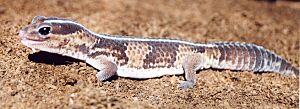African fat-tailed gecko facts for kids
Quick facts for kids African fat-tailed gecko |
|
|---|---|
 |
|
| Conservation status | |
| Scientific classification | |
| Genus: |
Hemitheconyx
|
| Species: |
caudicinctus
|
The African fat-tailed gecko or fat-tail gecko (Hemitheconyx caudicinctus) is a cool gecko that lives on the ground. You can find them in West Africa and Cameroon.
Contents
All About African Fat-Tailed Geckos
What They Look Like
African fat-tailed geckos belong to a special group of geckos called Eublepharinae. These geckos are different from others in a few ways. They are terrestrial, which means they mostly live on the ground. Unlike some other geckos, they have eyelids that can move, and their eye pupils are shaped like a thin line (vertical). Also, they don't have the sticky pads on their feet that help many geckos climb walls.
These geckos usually grow to be about 7 to 8 inches long. They can weigh up to 75 grams, which is about the same as a small apple. Female geckos are usually a little smaller than males. Their normal colors are brown and tan or beige stripes. They might even have a thin white stripe running down their back. Their belly is a light pink or off-white color.
Why Their Tails Are Special
The tails of African fat-tailed geckos are super important! They use their tails to store fat. This means if food is hard to find, their tails can keep them going for a while. Their tails also help them stay safe from predators.
Like many other geckos, they can drop their tail if they feel threatened. This helps them escape quickly from danger. Don't worry, they can grow a new tail! But the new tail won't look exactly like the old one. The original tail has ridges, but the new one will be smooth and a bit more rounded.
Where They Live
Home Sweet Habitat
You can find African fat-tailed geckos in West Africa, from countries like Senegal all the way to Nigeria. They also live a little bit into Central Africa, in northern Cameroon.
These geckos live in dry areas called the Sahel, and also in wet or dry savannahs. They like to spend most of their time hiding in dark, damp places. A favorite spot for them is inside a termite mound.
Interestingly, African fat-tailed geckos can look a bit different depending on where they live, even within Africa. Their size, scale patterns, and colors can change. This helps them blend in better with their surroundings, escape predators, and be successful at having more gecko babies.
How They Behave
Tail Tricks and Night Life
As we mentioned, African fat-tailed geckos can drop their tail if they are scared or attacked. The new tail that grows back will be more rounded, almost like their head. It might not even match the colors and patterns of the rest of their body. Remember, their tail is also where they keep their fat, which is like their emergency food supply. With enough fat in their tail, a gecko can go many days without eating!
African fat-tailed geckos are nocturnal. This means they are active at night. During the hot and dry daytime, they hide to stay cool and safe. When night comes, they come out to search for food. You might find them hiding under rocks, fallen logs, or in burrows during the day.
What They Eat
African fat-tailed geckos are mostly insectivores. This means they love to eat insects! They munch on different kinds of insects and other small creatures in their habitat. This includes worms, crickets, and sometimes even beetles or cockroaches.
African Fat-Tailed Geckos as Pets
African fat-tailed geckos have become quite popular as pets. However, they are still not as common as their close relatives, the leopard gecko. If you take good care of them, African fat-tailed geckos can live for 15 to 20 years. Some might even live longer!
Cool Color Morphs
Through special breeding, people who raise reptiles have created many different color versions of the African fat-tailed gecko. These different color patterns are called "morphs." Some common morphs include:
- Dominant:
- wildtype
- Incomplete dominant:
- whiteout
- Recessive:
- amel (albino)
- patternless
- oreo
- zulu
- ghost
- caramel


